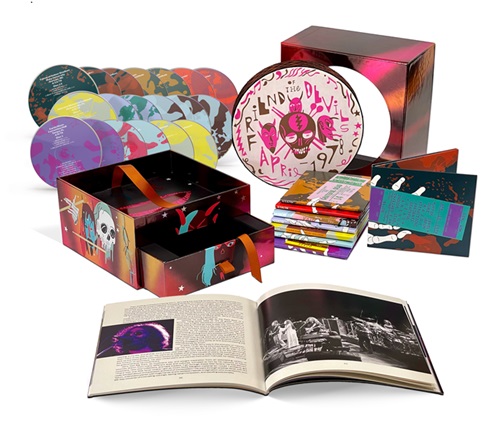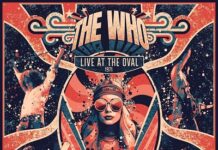When the drum solo comes around at concerts, lots of folks see that as an opportunity to head to the bathroom or beer line. When the “Drums” and “Space” sequence occurs at a Grateful Dead show, it’s time to get deep and go primal. But when did it become a thing? In his 1999 essay entitled titled The Evolution Of “Drumz And Space,” Michael Parrish writes what was first called ‘drums’ (or drumz, or Rhythm Devils) goes back to San Francisco at the Straight Theater on September 29, 1967, when Mickey Hart and Billy Kreutzmann first collaborated on a version of “Alligator” that lasted for two hours. Parrish goes on to say that it was during the Dead’s 1978 spring tour when ‘drums’ became a “ritualized part” of the band’s performances. Now, there are eight previously unreleased shows from that time period that capture the rise of “Drums” and “Space,” all bundled together in a 19-CD box set called Friend Of The Devils: April 1978.
By 1978, the Grateful Dead had grown into a ferocious, free-form live attraction. The hiatus in the mid 70s only emboldened them. Once Hart was back full-time with the group in 1976 after an extended absence, the seven-piece ensemble was poised to add more color and vibrations to an already thriving scene. Hart and Kreutzmann continued to refine the “drums” portion of Dead shows, transforming into the Rhythm Devils in the process. Friend Of The Devils: April 1978 pinpoints April 6 in Tampa, FL, as the date when “drums” became an essential part of every Dead show. By this time, it had matured and mutated with both Hart and Kreutzmann engaging in a percussional swordfight, counter-pointing the rhythms, adding different drums, percussive instruments, and other objects to hit that may or may not return sometimes odd, sometimes magical nuggets to bounce around your ear. The interaction between the two on April 6 was fierce and powerful, never losing its intensity as it rammed right into “The Other One.”
You simply can’t ignore the dynamics, the musicianship, and delivery of the entire band on these recordings, originally captured by Betty Cantor-Jackson and remastered using Plangent Processes tape restoration and speed correction by Jeffrey Norman. Jerry Garcia was at the peak of his powers as a guitarist, his fingers carrying the rest of the band through a myriad of psychedelic-flavored jelly jams. Bob Weir was also coming into his own as a songwriter, singer, and guitarist who instinctively knew (and still knows) how to work his oddball chord voicings, inversions and extensions into the mix. After you figure in Keith Godchaux’s ever nimble touches on the ivories as Phil Lesh’s angular basslines worm around the drums, it all meshes into this gorgeous, imitable wave of sonic goodness.
Plucking picks begin a heartfelt “Jack Straw” from Pembroke Pines on April 7 that finds Weir and Garcia, with help from Donna Godchaux, vocally sharp and in the cradle. There’s a cheerful rendition of “Deal” from April 8 in Jacksonville that finds the same three singers coming together in joyous harmony. They rise, fall, and easily melt into your ears. Meanwhile, put on your dancing shoes for a booming “The Music Never Stopped” from Atlanta on April 10. And brace yourself for a swaggering, adventurous combo plater of “Scarlet Begonias” and “Fire On The Mountain” from the next night in Atlanta, a pairing that would endure for the rest of the Dead’s 30-year run.
The first appearance of “Space” on Friend Of The Devils: April 1978 grows out of “Rhythm Devils” at the Jacksonville show. Garcia’s heavy use of the wah-wah pedals and assorted Mutron effects, beside Hart’s arsenal of percussion, Lesh’s high-frequency bass masterstrokes, and whatever cracks Weir could fill create an aura that would become routine, served fresh each and every time with a new sweet scent of wild weirdness to dazzle the senses. Just a few days later in Atlanta, the sequence was revisited and the whole enterprise emerged from a different dimension, with Garcia weaving the scales while Weir applied the framing and Hart banged out a mild clang for a couple minutes.
The April 12 show at Duke University’s Cameron Indoor Stadium in Durham, NC, is a centerpiece of the set, and available as a standalone vinyl, CD, and digital release. On this night, “Estimated Prophet” is executed with such intense precision and punctuality, it has to rank as one of the group’s best. “Truckin’” is a party on wheels with a pitch-perfect punch and “Wharf Rat,” described by one critic as a “passing-of-the-torch for the down-and-out,” slithers through into the soul of the audience like a stream of warm molasses tonic.
Individually numbered to 10,000 copies in a custom box designed by Steve Vance, Friend Of The Devils: April 1978 is rounded out by shows on April 14 at Cassell Coliseum, Virginia Polytechnic Institute in Blacksburg, VA, and April 16 at the Huntington Civic Center in Huntington, WV. A rare “Dupree’s Diamond Blues,” was trotted out on April 14, and wouldn’t be played for another four years. During the same show, a heavy “Drums” and “Space” clashes into another bombastic “The Other One” before Garcia brews up an emotive vocal on “Black Peter.” A spirited “U.S. Blues” on April 16 with a light “Thank you” ends the show, match and set. Eight concerts may sound like too much to take in. Nevertheless, once it’s all over and done, you’ll be tempted to reach for the repeat button at various intervals. At the same time, you’ll step back and realize that Friend Of The Devils: April 1978 is a major turning point for what would become a worldwide phenomenon with an impact that still resonates to this day.
~ Shawn Perry
Purchase
Friend Of The Devils: April 1978




















